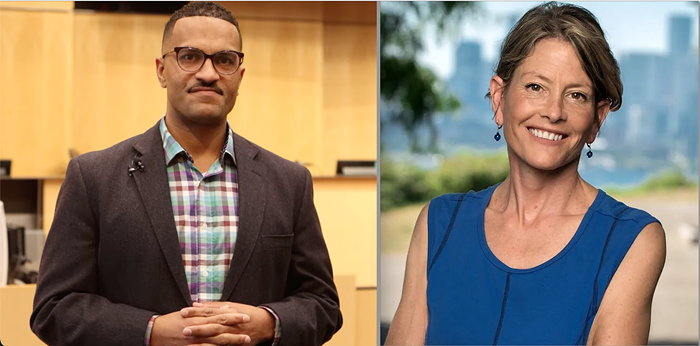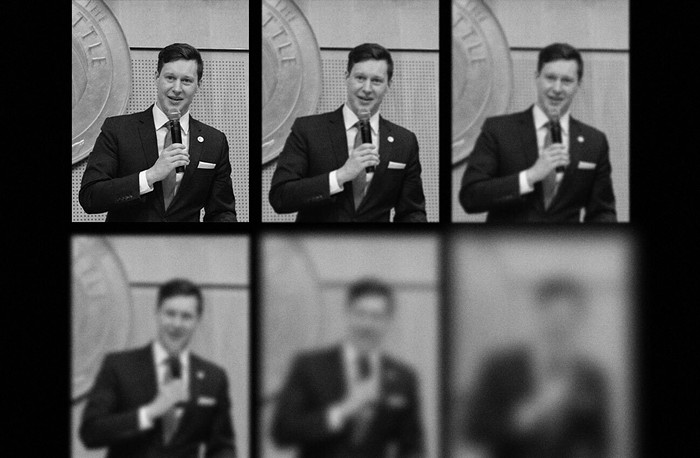The bearded hippie standing next to me is screaming for blood. We're watching the September 27, 2002, Ultimate Fighting Championship 39 on pay-per-view at Bomber's Tavern in Greenwood. On the television Randy Couture, a Lynnwood, Washington, native now living in Oregon, is fighting Ricco Rodriguez for the Ultimate Fighting Championship (UFC) heavyweight title. The title, formerly in possession of Seattle native Josh "The Baby-Faced Assassin" Barnett, is up for grabs because Barnett had it stripped by the UFC and the Nevada State Athletic Commission. According to those organizations, Barnett tested positive for steroids.
Cougar Boy invited me to the Greenwood UFC party. Cougar Boy (AKA Phil Anderson) is a former bike messenger who's fought one professional "extreme" bout in Vancouver, BC, and is currently waiting for his knee to heal before he resumes training. He's known as Cougar Boy because once, while mountain biking, he was tackled by a cougar, rolled on the ground with the animal, and choked it until it ran off. Anderson informs me that the bearded hippie with the sandals and hemp clothing is a friend of his named Glenn Barber, an accomplished Brazilian jiu-jitsu specialist soon to fight his first "no holds barred" match at Edmonds Community College.
The interchangeable designations "no holds barred fighting," "ultimate fighting," and "extreme fighting" are used in the U.S. largely because of cable pay-per-view events such as the Ultimate Fighting Championship. The UFC, begun in 1993, was originated by the New York-based Semaphore Entertainment Group and Brazil's premier jiu-jitsu masters, the Gracie family. Early UFC matches had no weight categories and gloves, and ruled out only biting and eye gouging. They were a guilty pleasure for people (mostly men) interested in seeing, and able to stomach, guys getting their faces bloodied and beaten. It was a genuine blood sport, matching fighters of wildly differing weights and backgrounds--some were martial artists and some were garden-variety bullies. The UFC was called "extreme" because it was extreme.
It was also growing fast. The UFC promoted itself as the baddest and bloodiest no-holds-barred fighting out there because doing so sold tickets and pay-per-view subscriptions. But in 1996, U.S. Senator John McCain of Arizona saw a tape of one of the events and quickly labeled it "human cockfighting." McCain sent a letter to every governor in the U.S., urging them to ban the sport in their states. Cable television companies were reportedly warned that broadcasting UFC events could jeopardize their influence in Washington, D.C. The UFC was forced to defend itself against the cable TV industry, its bread and butter, but it was too late. In 1997, TCI and Time Warner, the two biggest cable distributors, dropped the Ultimate Fighting Championship.
The online conspiracy theory goes like this: Senator John McCain's 1996 financial disclosure form showed that he owned between one million and five million shares of Anheuser-Busch company stock. His father-in-law owns Hensley & Company, an Anheuser-Busch distributorship that in 1996 was the second-largest beer wholesaler in the country. Anheuser-Busch, in the form of Budweiser beer, is the largest sponsor of professional boxing, a huge pay-per-view moneymaker. Therefore, ultimate fighting, in the form of the UFC, threatened boxing's domination of the pay-per-view market, and that's why Senator McCain squashed it.
This game of connect-the-dots would be easy to dismiss if it weren't for the consistently obsessive way that McCain went after ultimate fighting. He's called it "barbaric," "brutal," and "not a sport." Supporters of extreme fighting point out that the use of submission holds sometimes results in matches with no punching at all. Knockouts in extreme fighting occur much more quickly, since there's less padding on the gloves, making extreme fighting safer than boxing. "Dementia pugilistica," a term coined in 1937, captures boxing's true danger: The human brain sloshes around slightly when a person is hit in the head. If the blows occur round after round and year after year, chronic brain damage can be the cumulative result.
However, the real gauge of a sport's true danger is whether or not people die. Since 1884 there have been over 500 reported deaths of boxers in the ring. In comparison, ultimate fighting, though still in its infancy, has had only one reported death: An American named Douglas Dedge died after a fight in the Ukraine in March of 1998. It wasn't a sanctioned UFC match, but news of Dedge's death quickly crossed the Atlantic.
Five years ago the UFC began making changes in an effort to legitimize the sport. Rounds were shortened. Lightly padded gloves and weight classes were added. Head-butting and groin strikes were outlawed, along with elbow strikes to the back of the head and spine. The UFC was back on pay-per-view in 2001 and has been re-recognized by many states and their athletic commissions. Copies of UFC matches are readily available in most video stores. Even Sony's ubiquitous PlayStation has a fighting game based on the UFC. And in 2002 the Fox Sports network aired UFC fights and interviewed the fighters on The Best Damn Sports Show Period.
And a concerted effort has been made to use less violent terms to describe the extreme fighting. The most widely used and appropriate term is "mixed martial arts" (MMA), although "ultimate fighting" and "extreme fighting" are still popular with fans. But perhaps the oldest and most historically accurate term for the sport--i.e, "real" fighting based on as few rules as possible--is "pankration," a Greek word meaning "all powers." Pankration was an Olympic sport as early as 684 B.C., and many of its holds and techniques are depicted on the pottery from that era. The rules then were very similar to the rules that govern pankration today: no biting or eye gouging, and victory is secured by knockout, submission, or death.
It's time for Glenn Barber, the bearded jiu-jitsu hippie, to come face-to-face with his greatest fear: fighting no-holds-barred against an opponent he knows almost nothing about. This amateur event is being held at the Edmonds Community College gymnasium, but by the end of the night, there will be roughly 1,000 fans in attendance. Barber will have to violently destroy his opponent or use a painful submission hold to force him to submit, or "tap out."
Fighters glance around the Edmonds Community College gym, their scowling faces partially concealed by hooded sweatshirts. T-shirts with slogans such as "Tap Out or Pass Out--It Don't Matter to Me" and "Tap or Snap!" forewarn opponents and audience alike. Four seats from me a mother and her two daughters, roughly eight and five years old, soak up the testosterone-infused atmosphere.
Barber is an ultimate-fighting anomaly. He doesn't fit into this electrified atmosphere of intense gazes and razor-tight haircuts. Barber is 38 years old, and until recently he lived out of his truck or on a friend's couch. He possesses a mild disposition, and although he views himself as a warrior, his approach to fighting is mystic, not a macho bad-boy act.
Although he mixes spirituality with his fighting, Barber is not without genuine martial arts experience. But then again, he's never fought with so few rules. When asked why he feels compelled to challenge himself in this way, he says, "I had a lot of fear to deal with," then adds, "There is nothing more intense than one-on-one combat. This shit has always scared me to death." When asked why he needs this, he explains, "In martial arts, people train all their life and never test it. If you wanna get to another level, you gotta test it for real." And Barber is all about attempting to take himself to the next level, however that might be achieved.
A half-hour later, standing in the blue corner, Barber finally looks attentive and mean. His opponent looks 10 years younger, but Barber seems to be focused inward. In this sport guys routinely get knocked out in 20 seconds or less. With all the adrenaline, it must be easy to forget one's game plan...
And then there's the bell. After a quick rush across the ring Barber meets his opponent. Fists fly. Barber punches and connects. It isn't long before the two are chest-to-chest against the ropes, breathing heavily. After a powerful takedown, Barber scrambles for position, gains the top position, and begins his methodical Brazilian jiu-jitsu attack. Soon he's on his opponent's back, slipping his right arm under the man's chin. The choke is in. The match is soon over. Barber has exorcised a demon.
Back at Bomber's Tavern after the match, Barber sips what he calls "the best beer I've ever had." As we sit and drink he talks hyperbolically of the need to be ready to die for the sport. Propelled by his first victory, he begins to make claims that he is never going to lose. His sincerity is convincing. Barber's got the fight bug. He wants to see where fighting leads. He's going to fight again in Everett in two weeks.
The winner of the first Ultimate Fighting Championship in 1993 was the smallest man in the tournament, a 175-pound Brazilian jiu-jitsu (BJJ) master named Royce Gracie who worked his way through the tournament almost entirely unscathed. Sur- prisingly, he didn't knock anybody out during his march to the championship. Rather, his strategy was to get his opponent on the mat and force him to submit.
After winning three UFC tournaments in four years, Royce Gracie elevated BJJ to a standard part of the training regimen for fighters in the UFC. Fighters had to know how to defend against BJJ, and they were interested in mastering its holds themselves. At the height of all this attention, Royce Gracie proclaimed that his half-brother Rickson was 10 times better than he was. So who was Rickson Gracie, and how could we see him fight? The answers were not to be found in Brazil, but rather in Japan.
Japan's Pride Fighting Championships and K-1 are the premier MMA organizations in the world. Pride 23, which included a match involving Royce Gracie, recently packed 91,000 people into Japan's national stadium, the same venue that held 2002's World Cup soccer matches. Most fighters have their own action figures. Pride and K-1 dwarf the UFC because they attract the best fighters in the world. They attract the best because they pay the most.
Matt Hume and Maurice Smith train Bob "The Beast" Sapp, a former University of Washington football player who is now a household name in Japan; Sapp makes millions fighting for the K-1 organization. His notoriety in Japan is hard to exaggerate--he endorses hundreds of products, appears regularly on Japanese comedy shows, and has a huge-selling rap CD. If he goes out to eat sushi, the Japanese know about it. More importantly, they read about it--Sapp recently made the cover of TIME Asia. In June, he was featured in America on the front page of the Wall Street Journal.
Hume has done a lot of negotiating on behalf of fighters, both with the UFC and with Pride and K-1 in Japan. He estimates that on average, professional fighters in Japan are paid 10 times what UFC fighters get paid. At a local casino show, a new professional can expect to be paid somewhere between $300 and $500. A pro with a particularly good record or a guy who happens to be a dependable local draw can make from $3,000 to $5,000. If a fighter makes it to the UFC and is consistently successful, he might sign a contract for $10,000 per fight. Meanwhile, in Japan, even mid-level fighters routinely make $50,000. With the top names, the amount gets even more lopsided (the undefeated Rickson Gracie was paid $1.8 million for his last fight, and is rumored to be getting $4 million for his next match in Japan).
So while Royce Gracie was tweaking limbs in America, Rickson Gracie was making heaps of money in Japan. Rickson's reported record is 409-0; he won Japan's Vale Tudo (Portuguese for "anything goes") tournament in 1994 and 1995. He was an undefeated, mysterious, and even philosophical champion, and was therefore a huge draw whenever he fought. The documentary Choke chronicles the 1995 tournament and gives viewers a window into the mental and physical preparation of a fighter some still regard as the best in the world. His overall record, how much he demands to be paid, and his perceived unwillingness to fight the top names in the sport are debated in online MMA forums almost daily. But regardless of what MMA fans think about his ability to fight at this point in his career, almost all of them respect the fact that professional MMA fighters, both in Japan and the U.S., are getting paid more because of him.
The second floor of the Ballard Firehouse houses one of the Gracie satellite schools. Ralph Gracie Jiu-Jitsu is headed by Mamazinho, a black belt trained and certified by the famous Barra-Gracie school in Rio de Janeiro. Because the Ballard school allows first-timers to sit in on a class for free, I decided it was time to go and check out some Gracie-certified jiu-jitsu for myself.
It's 11:00 am and I'm pacing the mats in bare feet, wearing a borrowed gi (the normal attire for jiu-jitsu training and fighting). I'm feeling self-conscious, but I'm determined to get a feel for what makes Brazilian jiu-jitsu so lethal. Because Mamazinho speaks only minimal English, Walter, a student, acts as an interpreter. Walter's amused when I tell him that I'd like to go half-speed, maybe quarter-speed, and have Mamazinho show me the ground game, including the submission holds that prove effective in a real fight. Walter asks me if I'm going to resist, and I casually answer yes.
"Oh, so you want to get your ass kicked?" Walter asks, smiling at me.
Mamazinho squats on his hams and invites me to come at him. With my junior-high-level wrestling experience I know how to physically move around on a mat. I bull into him, grabbing arms and legs, and all of a sudden my elbow hurts. I'm on my knees, forehead on the mat, as if I'm reaching way under the couch for a lost cat toy. But Mamazinho is the cat and I'm the toy; he could easily shatter my elbow if he wanted.
We move on to other holds: ankle lock, knee lock, multiple varia- tions of the armbar, gi choke, rear naked choke, et cetera. Mamazinho puts me in a triangle choke while he's on his back. With his legs locked around my waist he quickly pulls one of my arms toward him, then plants his legs atop my shoulders. He arches, pulls and squeezes. I try to deal with it but resistance, as they say, is futile.
Afterward, I sit down and talk to Greg Jones and David Wood, the owners of Ralph Gracie Jiu-Jitsu. We touch on BJJ, the Gracies (Royce, Rickson, Renzo, and so on), and their roles in the world of MMA. They are candid about the fact that BJJ no longer dominates the fight world. Its continued evolution allows it to remain a potent weapon in MMA, but UFC and Pride fighters have done so much cross-training in martial arts that only a decade after Royce Gracie dominated the UFC it's hard to imagine him consistently beating athletes out of his weight category. According to AMC's Maurice Smith, MMA has evolved way beyond BJJ since the UFC's early days. "Each new generation of guys is making the new martial art," he says. However, it's not just the martial arts that are evolving, it's also the fighters' bodies; steroid use among MMA fighters is rampant.
Given the increasing amounts of money paid to fighters, it's no surprise that steroids are prevalent. The big question for the sport is whether or not testing is viable in any standardized form. Though local promoter Eric Wiseman says he doesn't know of anyone who is "juiced" at the amateur level, he freely admits that "a lot of guys are doing [steroids]." Jones estimates that two-thirds of professional UFC fighters are using steroids.
Seattle's Josh Barnett was stripped of his UFC heavyweight title for steroid use. According to Matt Hume, who is also Barnett's trainer and cornerman, the test and its results were a snow job. Apparently negotiations between Hume and the UFC were not going well. Barnett had fulfilled his fight contract with the UFC and, because he was the new heavyweight champion, attempted to secure higher pay for future fights. Then came the steroid allegations and the stripping of Barnett's title. "He tested positive for metabolites," explains Hume, "and they come from a lot of different sources." Hume had Barnett tested locally based on Olympic-level protocol and the results showed Barnett to be 100 percent clean.
Regardless of whether or not Barnett took steroids, Hume admits that the use of performance-enhancing drugs is widespread within the sport. Pride tests for steroids, but it's up to the organization itself to decide whether or not anything is done with the results. Meanwhile, Japanese fighters and spectators just don't seem to care; to them, catching a fighter with steroids is a bit like catching a model with makeup. Pride events are huge because they're events first and fighting exhibitions second. They are over-the-top in terms of theatrics, complete with fog and lasers. In Japan, the line between real and fake fights is further blurred by the inclusion of professional wrestlers. It is accepted that a fight or two might be staged. Big-name notoriety and drawing power trump the question of whether or not a national hero uses steroids.
Is this what the future holds for America and the UFC? Conventional wisdom says that violence sells. But is the American general public ready to accept fighters who are bigger, stronger, and conceivably able to do even more damage? Is there a point at which a disgusted public--or self-interested politicians--will object? The answer hinges on public perception. Watching genuine violence is still perceived to be more harmful to society than watching dramatic depictions of violence. But how do we gauge the harm to either the society or the individual?
Unless another political crusade shuts down the sport, the likelihood is that it will grow more violent and theatrical. Some martial arts purists hate to see their sport aping the theatricality of the World Wrestling Federation, but at the same time they know that showmanship may be the price to pay for growing the sport. And the emergence in Japan of American international fighting superstar Bob Sapp could go a long way toward opening the eyes of American fighting organizations, pointing to the fact that big money is made only when big money is paid.
But even if the sport stumbles and is driven out of business or underground again, people will always have a taste for extreme fighting. Sixteen hundred years ago one of the most influential figures in the history of Christianity, Augustine of Hippo (A.D. 354-430), wrestled with the same issue. "When he saw the blood," Augustine wrote of a friend, "it was as though he had drunk a deep drought of savage passion. Instead of turning away, he fixed his eyes upon the scene and drank in all its frenzy, unaware of what he was doing. He reveled in the wickedness of the fighting and was drunk with the fascination of bloodshed." H


















